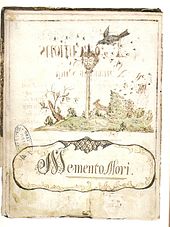Franz Joseph Wohlmuth
Franz Joseph Wohlmuth (born February 24, 1739 in Salzburg ; † March 26, 1823 there ) was the last public executioner in Salzburg and author of the Salzburg executioner's diary.
Life
On June 15, 1761, Franz Joseph Wohlmuth, the son of the Salzburg executioner Franz Wohlmuth and his wife Anna Maria, got a permanent job as Salzburg executioner, which earned him a fixed annual income of 150 guilders . In addition, there were fees for various activities of around 30 guilders and 150 guilders from the Wasenmeisterei .
As a supervisor, Wohlmuth lived, among other things , in the house at Herrengasse 30, which is located next to the joy house. In 1790 or a little later he was granted inheritance law in the old executioner's house (Freymann's house) in gneiss , located next to the high-prince's execution site , in which he had previously lived and that previously for almost three centuries the executioners and their servants as official residence. The old, important building has been preserved to this day (Neukommgasse 26) and is owned by the Martin farmer.
He carried out his task as executioner in Salzburg without much difficulty. Only in his old age did he commit malpractice, which brought him reprimand in 1807 and even three days' arrest in 1808. He then suffered a stroke. There is no record of executions from 1807 to 1812.
The entries in his diary show that from 1812 he worked again as an executioner and carried out executions , but he was also often represented.
He carried out his last execution with the sword on September 12, 1817 . According to his notes in the Salzburg executioner's diary, it should have been “happy and swift”. Franz Joseph Wohlmuth died on March 26, 1823 at the age of 85. He was buried on March 29th in the Morzger cemetery.
Executions Inscription Book - The Salzburg Executioner's Diary
Franz Joseph Wohlmuth wrote a diary during his service as the Salzburg executioner in which he recorded the tortures , executions and corporal punishments he had carried out from 1757 to 1817. The first entry from April 20, 1757 concerns Wohlmuth's master craftsman examination with the sword in the Bavarian regional and maintenance court .
Each entry was given a number by Wohlmuth, resulting in a total of 226 entries, all of which are very brief and formulaic. The title reads: " Executions registered book - To which all the pre-recorded and from me Franz Joseph Wohlmuth as accepted Freymann all over here both in the prince's city court and in the country carry out executions through the execution of the delinquents, then with the hearing of the tortures , and pillory posts, registered here in memorialized masses. starting with the year 1761 until ... "The executioner began with the date of the execution or corporal punishment and the place of the court. Next he recorded the names of the delinquents and their sentence. The entries conclude with the age, origin and occupation of the convicts.
Wohlmuth carried out executions both with the sword on 77 people and with the rope on 15 people. Almost all the severed heads were displayed on a stick (“Pfrill”) at the place of execution. Hanged people usually got stuck until they fell down by themselves. The courts have often imposed even more severe additional penalties. The executioner reports in diary entry no. 200 about a French soldier who was about to be hanged. His hand was cut off beforehand, Wohlmuth had to bandage the bleeding stump so that the convict would not bleed to death before the execution. The accused were also subjected to torture or severe torture in order to force them to confess, because without a confession they could not be convicted at the time.
Corporal punishment was also carried out and written down by Wohlmuth. So were delinquent at the pillory found with birch twigs carved and deported. The diary ends with the 226th entry, an execution by the sword on September 12, 1817. Franz Joseph Wohlmuth was 79 years old when he was last executed.
As a visible sign of the territory in which the sentence was pronounced, the convicts to be expelled were "branded" with a relegation letter. In Salzburg it was the letter "S" .
Wohlmuth had other duties typical of executioners in the 18th century . He was also a skinner or was master (= removing carcasses and recycling hides), his servants had to bury a total of nine people who had committed suicide, including two women. Suicides were not allowed to be buried in the cemetery, but only outside of the city in "unconsecrated earth". Suicides were mostly buried face down in a nearby bog at night.
The diary is one of the few remaining executioner's notes. It is a sober, concise and formulaic list of the punishments carried out, nothing is noted about personal matters such as income, his education, his views or his family. It seems to have only been a matter of precisely documenting his work and giving an account of it.
literature
- Constantin von Wurzbach : Wohlmuth (messenger) . In: Biographisches Lexikon des Kaiserthums Oesterreich . 57th part. Kaiserlich-Königliche Hof- und Staatsdruckerei, Vienna 1889, p. 249 ( digitized version ).
- Peter Putzer: The Salzburg executioner diary (writings of the institute for historical criminology, vol. 1). St. Johann im Pongau u. Vienna 1985
- Peter Putzer: From the Salzburg executioner diary (research on legal archeology and legal folklore, vol. 8). Zurich 1985
- Peter Putzer: The Salzburg executioner's diary from the perspective of folklore (Salzburger Heimatpflege, volume 3). OO 1987
Web links
| personal data | |
|---|---|
| SURNAME | Wohlmuth, Franz Joseph |
| BRIEF DESCRIPTION | Salzburg executioner |
| DATE OF BIRTH | February 24, 1739 |
| PLACE OF BIRTH | Salzburg |
| DATE OF DEATH | March 26, 1823 |
| Place of death | Salzburg |



